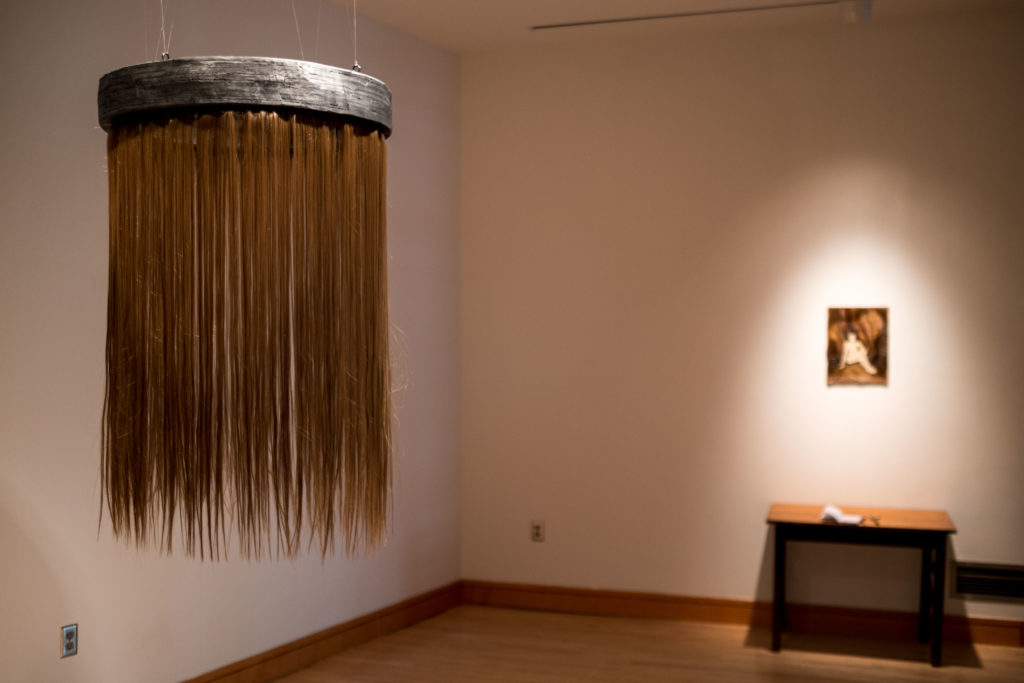
Steve Yang
yangstev17@grinnell.edu
Hair: we all have it, most of us know how to take care of it and some of us even know how to make cool weaves and braids with it. But designing art installations with hair is another beast altogether, as Reba Brooks ’17, a studio art and French double major, learned while creating the four pieces that make up “Gifts,” an exhibition now at the Smith Gallery.
“Something what might not come through really well is how difficult those materials are to work with,” Brooks said. “For the big installation, “Angel,” there were eight-foot long chunks with about three feet of hair … and there was so much frustration and care and anxiety that went into detangling it. I wish that was visible … You don’t see the effort.”
As a gallery exhibition, “Gifts” is a product and a reflection of Brooks’ various studies of the body, notably power symbolism. They noted the significance that the length and color of one’s hair has in performed gender roles in society, with regards to privilege and personality.
“A lot of my work concerns intersections of privilege,” Brooks said, gesturing at their long, blond hair. “It’s a pretty personal sort of narrative, and I’m interested in the way that people read me based on my hair, which I haven’t cut in four years, compared to me when I had a shaved head. …There was a lot less obligation to femininity when I was bald.”
Brooks mentioned their self-examination of this long blond hair and what it means in society.
“The gift of whiteness, the gift of coming off as ‘normal,’ cis and straight, as healthy.”
The connotation of this hair can be far removed from the reality of the observed, however, as Brooks added.
“It definitely hides my disability really well,” they said. “My hair has fallen out from being sick, which was an … obvious marker … on my body, although it’s grown back. Hair is really great at concealing things.”
Not all the hair pieces that Brooks originally created it made it into the installation. They described a “particularly nasty” chandelier made of “tangled resin icicles and hair covered in plastic, hung from 2 different circle shapes,” which was hard to interact with and was subsequently left out. The third crown in the set was also left out of the exhibition: made from a plaster mold of the hands of one of their friends, Brooks felt that the crown was too focused on masculinity for an exhibition dedicated to femininity.
Upon entering, it is apparent that the centerpiece of the installation is “Angel,” a halo of eight layers of plywood glued together, colored black with charcoal, supporting long strands of synthetic blond hair. Inside the halo, two footprints point towards the door, inviting the viewer to step inside and experience both the pressure and feeling of looking out under these wefts of hair, pausing to consider what societal expectations revolve around the hair on our heads.
Brooks wants people to touch this piece and to push past the grossness that we often associate with touching loose hair.
“I want people to try on my body, my identity,” they said. “I would love to cut [my long hair] all off.”
An open notebook nearby asking visitors to document their experience with Angel sits under a stylistically similar piece, “Icon.” Vivid with different hues of brown from mahogany, sepia and burnt umber to softer tones, “Icon” enshrouds a self-portrait of Brooks wearing the hand-crown in a resin base. The piece harkens back to Brooks’ family history, which is intimately associated with Russian Eastern Orthodoxy, luminous gold paintings of Jesus and icons in the home. Don’t miss the chance to see “Icon” — it could very well be one of a kind.
“I’m not sure I’ll be able to replicate it ever again,” Brooks said.

























































